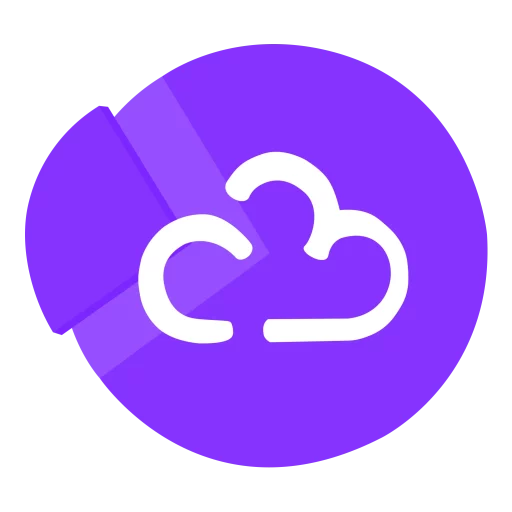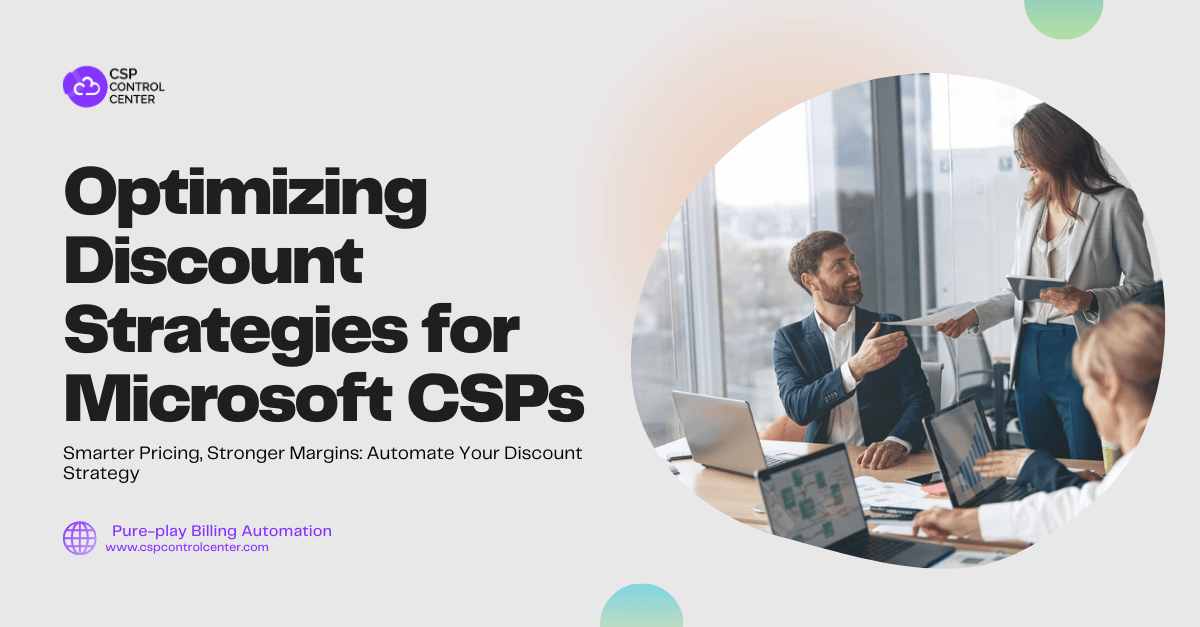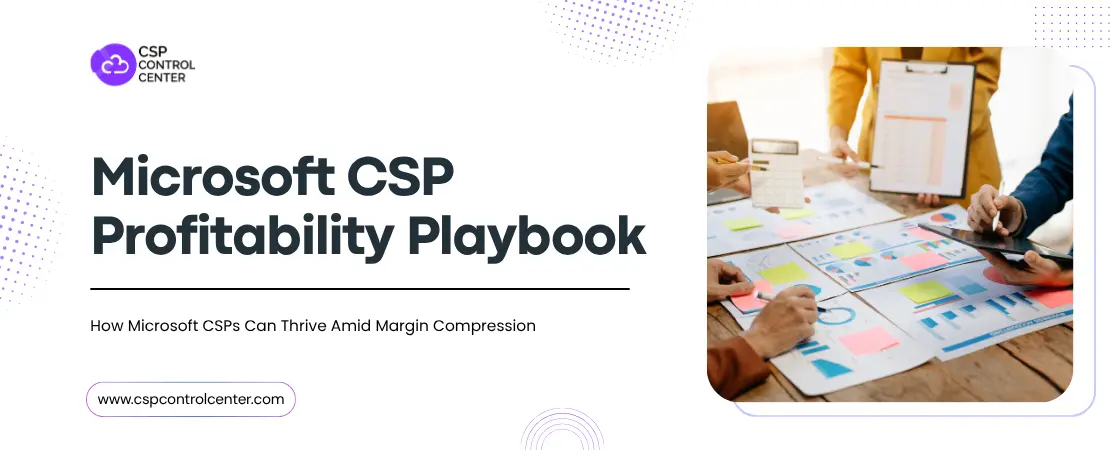In today’s highly competitive cloud marketplace, Microsoft Cloud Solution Providers (CSPs) need to find a balance between competitive pricing and profit margins. Though discounts and promotions can help you increase sales and drive customer loyalty, if these are not managed properly, they can quickly eat into your profits. If you fail to manage discounts properly, it can lead to revenue leakage, reduce your profits, and cause billing errors. Like many CSPs, you might be struggling with tracking discounts manually and ensuring compliance with Microsoft’s incentive programs. Without any real-time visibility into discounts, you might underprice services, offer over discounting, and end up losing revenue opportunities. Moreover, managing tiered pricing, custom discounts, and time-bound promotions adds another layer of complexity and increases the chances of billing errors.
To overcome these challenges, you need to leverage automated discount tracking and intelligent pricing tools within a robust CSP billing system. In this blog, we will talk about the importance of discount management in the Microsoft CSP Program, the challenges of manual processes, and how a CSP billing system simplifies discount and promotion management. We will also explore the key features to look for in a billing system and the best practices to ensure you are able to maximize profitability while staying competitive in the evolving cloud marketplace.
Understanding Discounts & Promotions in the Microsoft CSP Program
Microsoft offers its partners various discount opportunities and promotions to enhance competitiveness and profitability. Apart from the discounts and promotional pricing offered by Microsoft, you can also add your own discounts to stay competitive, reward loyal customers, or drive the adoption of specific services. To effectively manage the discounts and promotions in the Microsoft CSP program, you need to understand the types of discounts available.
Microsoft Partner Incentives
Microsoft offers a range of partner incentives to encourage CSPs to sell more licenses and cloud services. These incentives, which are in the form of rebates, discounts, or credits, can significantly boost your bottom line. These discounts include:
- Partner Earned Credit (PEC) – You earn rebates when your customers actively use Microsoft services like Azure. The rebates are based on customer usage and consumption.
- New Customer Incentives – Microsoft offers certain financial incentives for bringing in first-time Microsoft cloud customers. This helps offset customer acquisition costs and helps expand the customer base.
- Solution Incentives – Microsoft may periodically offer additional incentives for participating in specific programs or initiatives, such as those focused on specific industries or solutions.
You can learn more about Maximizing Revenue Through Microsoft Partner Incentives here.
CSP-Initiated Discounts
As a Microsoft CSP, you can offer specific discounts to attract new customers or retain existing ones. Here are common types of promotions you can offer:
- Volume Discounts – Offer lower prices when customers buy in bulk or commit to higher usage.
- Loyalty Discounts – Provide special rates to long-term or renewing customers to encourage retention.
- Tiered Pricing – Reduce the per-unit cost as customers scale up their subscriptions, creating an incentive to grow.
- Seasonal Promotions – Run limited-time offers during key periods like year-end deals.
Challenges in Managing Discounts & Promotions Manually
Managing Microsoft CSP discounts manually can lead to several operational challenges that impact profitability and efficiency. Manually handling discounts works as long as you are serving a small set of customers; as your business grows and you expand your operations, manual management of discounts can become increasingly complex, error-prone, and inefficient, leading to revenue leakage, compliance risks, and lost profitability. Here are some common challenges you may face while manually managing discounts and promotions as a Microsoft CSP.
Risk of Human Errors
One of the biggest drawbacks of manual discount management is the high risk of human error. While managing discounts manually, you depend mostly on spreadsheets and manual data entry, increasing the likelihood of mistakes. According to Gartner, “Every year, poor data quality costs organizations an average $12.9 million.” Apart from data entry errors, mistakes in calculations or failing to apply eligible promotions can lead to billing discrepancies. For example, if, due to an oversight, you apply a 20% discount instead of 15%, it can significantly impact profit margins, overlapping promotions can lead to double discounting, or missing promotions’ expiration dates can cause discounts to continue indefinitely. These errors can result in revenue loss, billing disputes, and customer trust issues.
Time-Consuming Process
Manually applying and reconciling discounts with Microsoft’s incentive payouts can take up a lot of time. Entering customer data, discount percentages, and promotional details into spreadsheets leads to the wastage of valuable time that could be used for strategic activities. Every time a new discount is introduced, or a promotional offer is updated, you must manually input the changes into your billing and invoicing system. If you are serving a large number of customers, this work could translate into days of work each month. Even after all this effort, you might fail to keep up with Microsoft’s updates on partner incentives and promotional programs, leading to the loss of potential incentive payouts.
Lack of Real-Time Visibility
With manual systems, you will struggle with real-time visibility into your discount programs and will be unable to track-
- Which customers are using which discounts?
- How much revenue is being lost due to promotions?
- Which discounts are driving the most conversions?
This lack of real-time insights leads to difficulty in making informed pricing decisions or adjusting strategies in response to market changes. It also makes it challenging to forecast the revenue impact of discounts and promotions offered.
Compliance and Audit Challenges
As a Microsoft CSP, there are some strict regulations and guidelines that you need to comply with. You need to maintain an accurate record of all the discounts applied, and if this data is spread across multiple spreadsheets or paper documents, then collecting information for audits becomes challenging. Incomplete or inaccurate records can lead to failed audits and penalties. In order to show compliance with Microsoft’s policies, you need to maintain accurate records of customer agreements, discount terms, and promotional details
Difficulty in Managing Multiple Discount Structures
You might be dealing with different discount types, including Microsoft partner incentives, limited-time promotions, volume-based discounts, or custom discounts for a specific set of customers. Each of these discounts will have its own terms and conditions and will require you to calculate the combined effect of multiple promotions manually. If you are manually managing discounts, you might apply incorrect discounts, leading to overcharging or undercharging a customer.
Customer Dissatisfaction
Applying incorrect discounts leads to inaccurate invoices and billing discrepancies. When customers receive incorrect invoices, they have to spend extra time and effort in getting the discrepancies resolved. This not only leads to a poor customer experience but also makes them lose trust in your services. According to the Customer Experience Trends Report by Zendesk, “After more than one bad experience, around 80% of consumers say they would rather do business with a competitor.” Billing errors also lead to delays in payment, impacting cash flow. If customers are unhappy, they might not renew their subscriptions and move to a competitor. Also, dissatisfied customers may leave negative reviews about your services, which will damage your business reputation.
How a CSP Billing System Simplifies Discount & Promotion Management
In the above section, we saw the challenges you might face while manually managing discounts and promotions as a Microsoft CSP. A robust Microsoft CSP billing solution can help you simplify discount and promotion management. Here is how a CSP billing solution helps:
Automated Discount Application
When you use a CSP billing automation tool, you can configure pricing rules and discount structures that will be applied automatically at the time of invoice generation. If discounts are applied automatically, it reduces the chances of error. You can set start and end dates for promotions to prevent over-discounting. Automation can help streamline discounting and minimize billing disputes.
Real-Time Margin Monitoring
A CSP billing automation tool helps you monitor margins in real time. This will help give you visibility into the performance of different discounts and help you assess which discounts to keep and which to discontinue. You can set up predefined thresholds to protect profit margins while offering competitive pricing.
Advanced Reporting and Analytics
A Microsoft CSP billing tool does more than just automating invoice generation, it provides you with detailed reports and analytics on discount usage, customer purchasing patterns, and revenue impact. You can generate reports such as:
- Discount performance reports – Track which promotions generate the most conversions and revenue.
- Customer segmentation – Analyze how different customer groups respond to discounts.
- Forecasting – Predict future revenue impacts before rolling out new promotions.
These reports can help you fine-tune your pricing strategies, target your promotions more effectively, and make better data-driven decisions.
Audit & Compliance Management
Microsoft’s incentive programs have strict guidelines, and if you fail to track and report discounts properly, it can lead to compliance issues, financial losses, or even penalties. A robust billing system helps you track every discount applied, generate detailed audit trails, and ensure that you are complying with all the relevant regulations. This detailed level of documentation makes audits easy and helps maintain credibility and trust with Microsoft and your customers.
Seamless Integration with Other Systems
For discounts and promotions to work effectively, they need to sync seamlessly with your other business tools, such as:
- PSA (Professional Services Automation) tools – Sync discounts with project billing.
- CRM systems – Apply customer-specific promotions based on contract terms.
- Accounting software – Ensure financial data flows smoothly across departments.
These integrations eliminate manual data entry, reduce errors, and ensure a unified billing experience.
Key Features to Look for in a CSP Billing System
When selecting a CSP billing system, ensure it includes the following capabilities to streamline discount and promotion management:
Automated Pricing & Discount Management
Look for a system that supports dynamic pricing rules and applies discounts automatically. The billing system should allow setting up of pre-defined discounts structures like percentage-based, fixed amount, or tiered pricing. You should also be able to set expiration dates to prevent errors and over-discounting. This ensures discounts are applied accurately, reducing billing disputes and improving customer trust
Subscription & Billing Automation
The billing automation tool that you choose should be able to handle recurring billing with proration for mid-cycle changes. The system should handle billing cycles, renewals, and adjustments without the need for manual updates. It should also offer multi-currency and tax compliance support to serve global customers. This reduces your administrative overhead and ensures timely, accurate billing.
Advanced Analytics & Reporting
Your billing solution should offer robust reporting capabilities that allow you to track the performance of your discounts and promotions. These should include customer purchasing behavior, revenue trends, discount utilization, and promotion effectiveness over time. With access to detailed metrics, you can identify which offers drive conversions and which customers respond best to certain incentives.
Multi-Tenant & Scalable Architecture
As your customer base grows, your billing system should be capable of handling the increased number of subscriptions. A multi-tenant architecture allows you to manage multiple customers under one platform without performance issues. Scalability is equally important, the system should handle increasing data volumes, complex pricing rules, and evolving customer needs. Whether you are onboarding new customers, expanding into new regions, or adding services, the billing platform should scale effortlessly to support your growth without compromising speed, accuracy, or uptime.
Integration Capabilities
Your billing tool should integrate easily with existing business systems like PSA (Professional Services Automation) tools, CRMs, and accounting platforms. When your billing platform connects with these systems, it eliminates silos, keeps data consistent, and cuts down on repetitive manual tasks. This way, there will be no discrepancies between platforms and customer details, discounts, invoices, and financials will be in sync.
Best Practices for Managing Discounts as a CSP
As a Microsoft CSP, offering discounts can help you win business and reduce customer churn, but to succeed, you need to manage the discounts and promotions effectively. By implementing best practices, you can optimize your pricing strategies, protect your margins, and ensure compliance with Microsoft’s program requirements. Here are some best practices that you can follow:
Define a Clear Discount Strategy
Start by creating a well-documented discount policy. Define your goals, whether it is increasing market share, boosting sales of specific services, or retaining high-value customers. This will help align discounts with business objectives. To prevent over-discounting, define clear limits on the types, duration, and amounts of discounts you can offer. Also, decide who can approve discounts and what types of customers qualify.
Use Automation Wherever Possible
Use a robust CSP billing automation tool to automate discount application, invoicing, and reporting to minimize errors and improve efficiency. Define pricing rules and discount structures that can be automatically applied based on customer segments, product categories, or promotional periods. Integrate your billing system with PSA and accounting tools to streamline data flow and reduce manual data entry.
Choose the Right Discount Types
Not every discount will attract all customers. Offer discounts based on customer needs, deal size, product categories, etc. You can offer-
- Volume Discounts: Offer discounts based on the volume of services purchased.
- Promotional Discounts: Use time-limited promotions to drive short-term sales or customer engagement.
- Customer-Specific Discounts: Offer tailored discounts to strategic partners or high-value customers.
- Bundled Discounts: Offer discounted packages of multiple services to increase sales and customer loyalty.
Monitor Margins in Real Time
Leverage a CSP billing automation tool to gain visibility into promotion performance. This will help you assess the financial impact of the discounts offered. You can set up thresholds and receive alerts when margins fall below certain levels. This will help protect margins and prevent underpricing. Depending on this data, you can adjust your pricing strategies.
Ensure Compliance & Audit Readiness
Keep detailed records of all discounts applied, including customer agreements, promotional details, and approval documentation. Use a CSP billing automation tool to generate audit information that can help in compliance. Establish internal controls to prevent errors and ensure compliance with discount policies. Regularly review Microsoft’s program updates and ensure your discount management practices align with the latest guidelines.
Regularly Review Discount Performance
Regularly analyze the performance of your discounts and promotions. Use analytics to see which discounts are driving revenue and which ones are not. Adjust your discount strategies based on performance data and market conditions. You can also gather feedback from customers on your discount offerings.
Provide Comprehensive Training
Ensure your sales and support teams understand the discount policies and procedures. Provide thorough training on how to use your CSP billing system for discount management. Your team should also be trained to communicate discount policies to customers to avoid misunderstandings and build trust.
Simplify Discount & Promotion Management with CSP Control Centre (C3)
Are you struggling with manual discount errors, margin erosion, or Microsoft compliance risks? With C3, you can automate discount application, set flexible pricing rules, and generate audit-ready reports with ease. With real-time visibility into margins, performance, and customer behavior, you can make better decisions. In addition to this, seamless integrations with PSA tools like ConnectWise Manage and Datto Autotask and accounting software such as Quickbooks, Xero, etc., keep your operations in sync and error-free.
Book a demo to learn how CSP Control Centre can help in managing discounts and promotions for your Microsoft CSP business.

 CSP Control Center
CSP Control Center
 CloudEvents
CloudEvents


